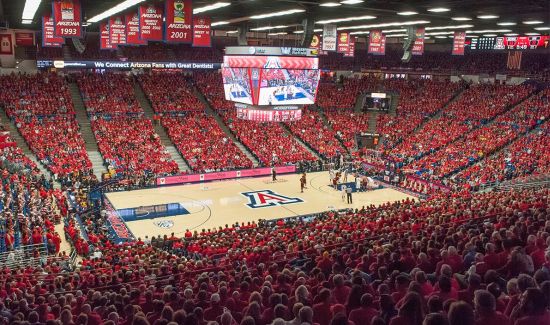The Pac: Way Back?
Posted by Andrew Murawa on April 2nd, 2015Three Sweet Sixteen teams. One in the Elite Eight. And yet when the Final Four rolls around this weekend, it will commence without an entrant from the West Coast’s major conference, the Pac-12, for the seventh consecutive season. Arizona has nothing to be embarrassed about from its loss to Wisconsin on Saturday. Utah and UCLA both put up good fights before going down to clearly superior teams. But this is turning into something of an issue. Since the last time a Pac-12 team advanced to the Final Four (UCLA, 2008), four different Big Ten schools have earned a total of seven spots in the sport’s final weekend. The Big East has earned seven as well, although all of those but Villanova have scattered in the wind to different conferences (the new Big East does have Butler, however, which earned two Final Four appearances as part of the Horizon League). Even conferences like the Colonial (VCU, 2011), the Missouri Valley (Wichita State, 2013) and the newly formed American (Connecticut, 2014) have Final Four appearances since the last Pac-12 appearance.
Furthermore, if you throw out UCLA’s three straight appearances from 2006-08, you have to go all the way back to 2001 to find another Pac-12 school (Arizona) with a Final Four appearance. In the history of the conference that starts with the word “Pacific” and ends with a number, only three schools (UCLA, Arizona and Stanford) have made the Final Four. Current member Utah got to the final weekend back in 1998 (and in 1966, for that matter) as a member of the WAC, and had previously earned spots as a member of the Mountain States conference in 1944 and 1961. Refer to the bottom of the page for the complete list of when teams in the conference last reached that level of success. So, really, I didn’t sit down expecting to write the above. I was just going to write a simple season wrap-up and wound up diving down a rabbit hole. Now I’m left with these burning questions: 1) Why does the Pac-12 find itself in such dire straits? And 2) is there any hope of significant change? Let’s dive right into the first one with the caveat that, even after thinking about this for 24 hours, I’m not sure I have a great answer. So, we’ll leave it open for further discussion. Feel free to shoot down any of my theories and propose your ideas along the way.













































